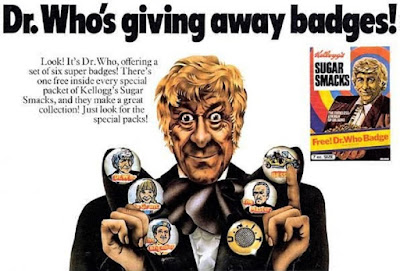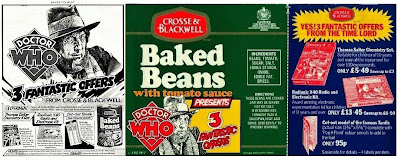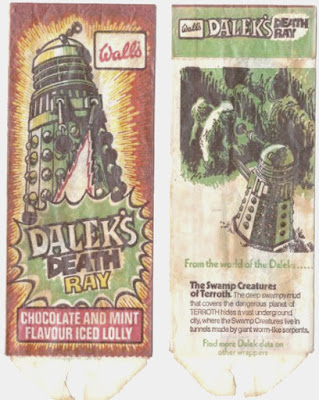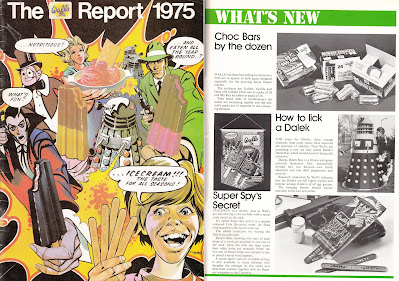Leeds-born Denys Fisher was a military component engineer before inventing the Spirograph drawing aid in 1965. In 1977 Fisher and Mego developed a small range of 10" DOCTOR WHO toys. The Denys Fisher/Mego Cyberman used serials THE INVASION and REVENGE OF THE CYBERMEN as inspiration, although for reasons unknown a button nose was added. The set was completed by a Fourth Doctor with more than a passing resemblance to Gareth Hunt, Leela, a Dalek, a Giant Robot held together with elastic bands, and a TARDIS. K9 was added a year later.
Dapol, the Welsh model railway manufacturer, produced some inaccurate DOCTOR WHO action figures between 1988 and 2001. The line included a two-handed Davros, a five-sided TARDIS console and a green-painted K9. A publicity shot used to make the latter showed K9 on grass, where reflections gave a green impression.
1965 saw the release of Berwick's Dalek Playsuit. Packaged in a large box, the costume comprised of a red plastic dome atop a cardboard neck to look through, over which was slotted a vinyl skirt with white hemispheres. An eye fitted into the dome, with the plunger and gun arm held through holes. The Berwick catalogue of 1977 contained a creepy Tom Baker Playsuit.
In 1978, Jotastar released the Doctor Who and the Legendary Legion Top Trumps set. Although the heroes had The Fourth Doctor and the TARDIS, the rest were made up of characters from history, myth and literature. Presumably the designers opted for this route because they had no real interest in the show, and they pulled the alien cards from thumbing through Target tie-ins. The artwork is indifferent and there is a distinct anomaly: even though we have Dalek-related entries such as Davros, Ogrons, Mechanoids and Draconians, the Daleks themselves do not appear due to Terry Nation copyright.
In the same year, German company Dubreq - who invented the Stylophone - issued two notorious Horror Top Trumps: Devil Priest and Dracula. These had gaudy pen and ink drawings "inspired" by all aspects of horror culture, and the style reminds of the amended pre-code comics put out by Eerie Publications. DOCTOR WHO contributes to two cards in the Devil Priest collection: the Fire Demon is obviously Azil from THE DAEMONS, and a Sea Devil becomes a jailer for the Venusian Death Cell.
In 1971 Kelloggs ran a DOCTOR WHO promo in packs of Sugar Smacks behind this almost paedophilic illustration of Jon Pertwee. Free inside were one of six metal badges: Third Doctor, The Master, Bessie, Jo Grant, Brigadier or the Unit Symbol.
In 1973, The Co-Op published budget cookbook Baking Your Cake And Eating It, with recipes sent in by the public. On the back cover, a Jon Pertwee illustration explained that “men may go shooting off to outer space but it’s really their inner space that matters most.”
In 1977, Crosse & Blackwell had a DOCTOR WHO offer ("to get together ... and set up a super home science lab.") Tokens could save you money on a chemistry set and a radio/electronic kit, plus for 95p you could have a cut-out TARDIS with colour pencils.
The 'Tardis Tuner' was released by the Shortman Trading Company in 1978. Actually a black medium wave radio, there were flashing lights and a "Time Warp" bleeper control switch. Shortman also produced a promotional one-page comic strip, which had The Doctor and Romana use the device in their escape from the steel dungeons of The Turgids.
Retailing for 85p, these Fourth Doctor underpants were available from British Home Stores in 1980.
In 1984, W. H. Allen & Co published The Doctor Who Pattern Book by Joy Gammon, providing instructions for making scarfs, jumpers, pillows and toys to knit and sew.
The Souvenir Press/Panther Books Dalek World Annual of 1965 includes a number of show-stopping facts. Did you know, for example, measles came from a Dalek space probe? The Great Pyramid of G(h)iza marks the spot of a crashed Skaro craft? And, most chilling of all, that a Dalek never sleeps?
In 1979, Goodies produced Doctor Who Candy Favourites, white chocolate snacks in four different shapes: the TARDIS, K-9, a Dalek and a Cyberman. A year later four pieces of each were made available in a rectangular box.
Argo’s 1976 LP Doctor Who and the Pescatons was the first original audio adventure for the Time Lord, voiced by Tom Baker and Elisabeth Sladen and written by Victor Pemberton, who had penned DOCTOR WHO - FURY FROM THE DEEP. Doctor Who and the Pescatons sees The Doctor defeat the “cunning, ravenous creatures; half-human, half-fish” invaders of Earth by high-frequency sound. Argo, an imprint of Decca, faced a number of obstacles from the BBC, the corporation alarmed that - due to an oversight at BBC Enterprises - rights had been secured for £50.
The BBC started producing vinyl sound effects records in 1969, part of various tie-ins from BBC Radio Enterprises (which would morph into the BBC Records banner then BBC Records and Tapes). Of interest here are the three science fiction and three horror entries in the series. Out of This World (Volume 12, 1976) has four themes (Outer Space, Magic and Mystery, Suspense and the Supernatural, and The Elements); the quirk of Doctor Who Sound Effects (Volume 19, 1978) was that it used original production titles rather than the broadcast serial names (THE DESTRUCTORS is actually THE SONTARAN EXPERIMENT); and Sci-Fi Sound Effects (Volume 26, 1981) extensively featured BLAKE'S 7, but also contained audio from Tom Baker's final DOCTOR WHO season, the original 1978 radio dramatisation of THE HITCHHIKER'S GUIDE TO THE GALAXY, and the 1981 Radio 4 serial EARTHSEARCH.
Despite Mary Whitehouse accusing the BBC for "an utter lack of responsibility," Death & Horror (Volume 13, 1977) was a great success, becoming the first sound effect LP to enter the UK Album Chart. Who could not be impressed with the six segments: Execution and Torture, Monsters and Animals, Creaking Doors and Grave Digging, Musical Effects and Footsteps, Vocal Effects and Heartbeats, and Weather, Atmospheres and Bells?; unlike its predecessor, More Death and Horror (Volume 21, 1978) isn't arranged in handy sections, instead its a torrent beginning with Death of a Fly and ending with Suicide by Gas; and Even More Death and Horror (Volume 27, 1982) only runs to twenty-seven minutes, but we are back to sections with the most hyperbolic track lists (Whipping - A Touch Of The Lash Keeps You On Your Toes (Or Knees) or Dragon - On The Move Through The Bushes - With Occasional Flaming Bad Breath).


































